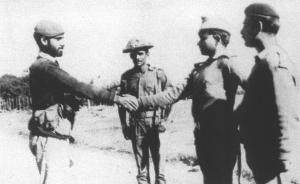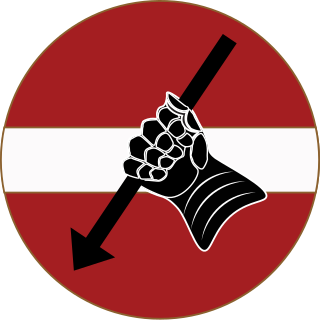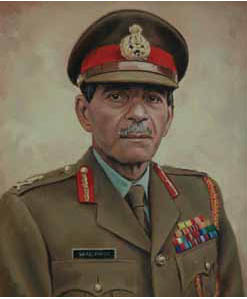
The III Corps is a formation of the Indian Army that was formed during World War I in Mesopotamia during its respective campaign. Prior to the reorganization of the British and Indian forces in Mesopotamia, it was designated as the Tigris Corps.

The First and SecondBattles of Hilli were two major battles fought during the Bangladesh Liberation War on 22–24 November and 10–11 December 1971. They are generally regarded as the bloodiest battles of the eastern front of the Indo-Pakistani War of 1971. The first battle saw, according to veterans of the battle, the fiercest fighting of the war, but the second was much tamer.
The 6th Infantry Division was an infantry division of the Indian Army during World War II, created on 1 March 1941 in Secunderabad. On 11 September 1941 it was shipped to the Iraq and later Iran. During 1942 and 1943 it was part of the Tenth Army. The division remained in the Middle East where it was disbanded on 15 October 1944 in Basra, Iraq. During World War II its commanders included Major-General James Noel Thomson, Major-General Arthur Holworthy, and Major-General B.H. Chappel.
I Corps is a military field formation of the Indian Army. The Corps is headquartered at Mathura in Uttar Pradesh. It was raised on 1 April 1965. It was still being raised when it was despatched to the front in 1965. Raised as the First Strike Corps of the Indian Army, it was launched into operations in the Sialkot sector. The Corps conducted a counteroffensive during the Indo-Pakistani War of 1965. In the 1971 war against Pakistan, it took part in the Battle of Basantar.

Lieutenant General Sagat Singh, PVSM was a General Officer in the Indian Army, notable for his participation in liberation of Goa and later in Indo-Pakistani war of 1971. He held many commands and staff appointments throughout his career.

Lieutenant General Harbaksh Singh, VrC was a senior General Officer in the Indian Army. As the Western Army Commander, Singh commanded the Indian Army forces and played a key role during the Indo-Pakistani War of 1965. For his role in the war, he was awarded the Padma Vibhushan in 1966.

The IV Corps is field a corps of the Pakistan Army, headquartered in Lahore, Punjab, Pakistan. Having established in January 1966, it is Pakistan army's of one of ten maneuver formation which saw its deployment against the Indian Army in 1971.
The Indian Army had no standby force ready in 1971 with the specific task of attacking East Pakistan, one of the many reasons why India did not immediately intervene after Pakistan launched Operation Searchlight in March 1971. Indian Army's Eastern Command was tasked with defending the northern and eastern borders and fighting the insurgencies in Nagaland, Mizoram and Naxalites in West Bengal at that time.

The IV Corps, or the Gajraj Corps, is a military field formation of the Indian Army, covering the states of Assam and western Arunachal Pradesh.

II Corps is a corps of the Indian Army, based in Ambala and known as Kharga Corps.

XIV Corps or Fire and Fury Corps is a corps of the Indian Army. It is a part of the Army's Udhampur-based Northern Command. The 14 Corps looks after military deployment along Kargil-Leh and looks after the frontiers with China, Pakistan and also guards the Siachen Glacier.
The XI Corps of the Indian Army is based in Jalandhar and is a part of Western Command.

Prior to Bangladesh Liberation War in 1971, India had no plans for large scale military action in East Pakistan. Since the Sino-Indian War of 1962, the primary objective of the Indian Army Eastern Command was the defence of the Indian northern and eastern borders, defending the "Shiliguri Corridor", and on combating insurgencies raging in Mizoram, Nagaland, Manipur and the Naxalites in West Bengal.

The Eastern Command is one of the six operational commands of the Indian Army. It is headquartered in Fort William in the city of Kolkata in the state of West Bengal. The Eastern Command was formed on 1 November 1920. The Command is commanded by a three-star rank officer with the title General Officer Commanding-in-Chief (GOC-in-C).
Lieutenant General Khem Karan Singh MVC was a General Officer in the Indian Army. He was awarded Padma Bhushan for his services to the nation during the 1971 war. He also received Maha Vir Chakra for his services during 1965 Indo-Pakistan war.

Lieutenant General Walter Anthony Gustavo 'WAG' Pinto, PVSM was a General Officer in the Indian Army. He last served as the 8th General Officer Commanding-in-Chief of the Central Command. As a major general, he led the 54th Infantry Division on the western front in the Indo-Pakistani War of 1971, for which he was awarded the Param Vishisht Seva Medal.
Prem Nath Hoon was an Indian military officer who was the General Officer Commander in Chief of the Western Army of the Indian Armed Forces from 1986 to 1987. He had commanded mountain brigades, infantry brigades, infantry division and the XV Corps in Kashmir.
Lieutenant General Joginder Singh Bakshi MVC, VSM was a General Officer in the Indian Army. He was decorated with the Maha Vir Chakra for his role in the Indo-Pakistani War of 1971.
Major-General Lachhman Singh Lehl PVSM, VrC was a highly decorated Indian Army general and military historian noted for his command of the 20th Mountain Division in the Battle of Hilli during the Indo-Pakistani War of 1971.
Indian order of battle during the 2020–2021 China–India skirmishes:











